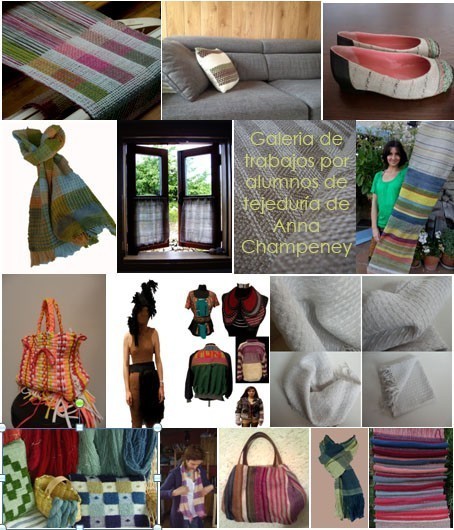¿Te interesa realizar un curso online de tècnicas del tejido en telar con Anna Champeney?Si te interesa aprender técnicas de diseño y tejido en telar de bajo lizo online, escríbanos y suscribir a nuestro boletín.
 Contacta con nosotros |  Marta Bahillo knitwear for children. Matilde, Babáa´s young model, is wearing a Marta Bahillo oversize t-shirt made from organic Brazilian cotton. We recently had the pleasure of a visit by Spanish knitwear designer Marta Bahillo, with her family including her daughter, Matilde (aged 3 and a half) who also acts as a model for Marta´s children´s collections. We sent Matilde on an itinerary a mission to pick different plants in the garden. These included the eucalptus (Eucalptus cordata) planted about 4 years ago for Anna Champeney Estudio Textil as an experimental dyeplant. This eucalptus is one of dozens of types of eucalptus but is not the common variety planted in many parts of Galicia over a century ago. The seed came from Chiltern Seeds by post and were interested in this species in particular as it is one of the varieties which can reputedly produce orange dyes. Anna will be cropping the tree for the first time ever next week with a private dye pupil. Orange is not an easy colour to achieve with eucalptus and colours vary according to local growing conditions but whatever happens, the plant will produce good dye colours of some kind  You may remember a previous post about Marta Bahillo when she was learning to use natural dyes at natural dyes at Anna Champeney Estudio Textil in 2012. You may remember a previous post about Marta Bahillo when she was learning to use natural dyes at natural dyes at Anna Champeney Estudio Textil in 2012.
She has been very busy since then launching her children´s collection which you can buy direct from the online shop Babáa. Organic cotton, Spanish wool and over-size design which mean the clothes will last longer. It´s a good chance to support quality Spanish design with a focus on environmentally-friendly working practices. If you hurry you can enjoy summer sale prices before the autumn/winter collection 2013/14 comes in. We hope to be able to report on future a an exciting future collaboration between Anna Champeney Estudio Textil and Marta Bahillo over the coming months and into 2014.  Marta Bahillo knitwear collections – What Matilde is wearing 
An idyllic photo isn´t it! Actually it´s part of our regular housekeeping at textilesnaturales to keep our stored yarns free from damage by clothes moths. After every summer course or weave project we pop the wool which has been out in the course room into our big freezer for a few days and then air it (in the shade, if it´s dyed). The cold temperature kills moths, eggs or larvae. Only then do we return the yarn to its storage boxes or bags which we try to keep as firmly sealed as possible. We keep a firm control of the stock, ensuring that moth balls are place in with the yarns and changed every 6 months. Undyed wool yarns we take out into the bright summer sunlight – as larvae are killed by the light. We also put waste woolen yarn in tempting places so that they lay their eggs there instead of on our “real” yarns. Tempting places are low down, dark and out of drafts, preferably in a slightly damp position. Every few weeks, in summer, we put these decoy yarns in the freezer and then in brilliant sunshine to kill any moth presence on them. One year we tried pheramone moth traps but there wasn´t much success there. Either they didn´t work or our other measures were successfully keeping our studio and stores relatively moth free. So far so good!  Here you can see textiles woven by some of our pupils – both beginners and those of a more advanced level. Here you can see textiles woven by some of our pupils – both beginners and those of a more advanced level.
Some of the photos are of pieces made in the courses themselves, others made by students on their looms at home. All woven textiles (except those from ESDEMGA students) were woven on Louet table looms. You can see the sheer versatility of these compact little manual cloth weaving machines – scarves, cushions, curtaining … even fabric for shoes! If you are one of our pupils then don´t lose touch with us – we´d love to see your latest work and feature it on a future gallery. And if you´re not one of our pupils then !Animo! Go for it! Learn to weave your own beautiful and special fabrics on handlooms on one of our courses. We offer English language support if you´re not confident about your Spanish, and have limited availability every year for some one-to-one tuition which we can give in English. Próximos cursos (Next courses) Pupils: Thanks to Tracey, Kathleen, Gonzalo, Carmen, Itziar, Enriqueta, students of ESDEMGA fashion school, Gerda, Tracey, Adela, Myfanwy and Solé whose work is on display here. |
Pago seguro
 NUEVO Octubre 2023 Curso presencial setmanal de teixits de baix lliç (Girona)!Un curso nou, setmanal (3h) a Sant Gregori, Girona, amb l'Anna Champeney. Trimensual, plaças limitadas).
Octobre 2023. Ven a aprender a diseñar y realizar tejidos en telar de bajo lizo a mano. Docente: Anna Champeney, profesional desde 2004, con marca textil propia, experta en tejido de bajo lizo, docente en la Escola Massana, Barcelona.
 Haga clic aquí para informarte |

 You may remember a previous post about Marta Bahillo when she was learning to use natural dyes at natural dyes at Anna Champeney Estudio Textil in 2012.
You may remember a previous post about Marta Bahillo when she was learning to use natural dyes at natural dyes at Anna Champeney Estudio Textil in 2012.







